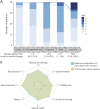Early-Stage Contactin-Associated Protein-like 2 Limbic Encephalitis: Clues for Diagnosis
- PMID: 36288995
- PMCID: PMC9608385
- DOI: 10.1212/NXI.0000000000200041
Early-Stage Contactin-Associated Protein-like 2 Limbic Encephalitis: Clues for Diagnosis
Abstract
Background and objectives: Previous studies suggested that autoimmune limbic encephalitis with antibodies against contactin-associated protein-like 2 (CASPR2-encephalitis) is clinically heterogeneous and progresses slowly, preventing its early recognition. We aimed to describe the onset and progression of CASPR2-encephalitis and to assess long-term outcomes.
Methods: We retrospectively analyzed the medical records of all patients whose CSF tested positive for anti-CASPR2 antibodies in our center between 2006 and 2020. Standardized telephone interviews of all available patients and relatives were conducted, assessing long-term functional independence using the Functional Activity Questionnaire (FAQ) and quality of life using the 36-Item Short-Form Survey (SF36).
Results: Forty-eight patients were included (98% males; median age 64 years), and 35 participated in telephone interviews (73%). At onset, 81% had at least 1 neurologic symptom among the following: limbic (54%), peripheral nerve hyperexcitability (PNH; 21%), and/or cerebellar symptoms (17%). Most of the patients (75%) had initially symptoms of only one of these categories. Limbic symptoms at onset included mostly seizures (33%), while memory disturbances were less frequent (10%). PNH signs were mostly neuropathic pain (9/10 patients). Other symptoms seen at onset included asthenia (33%), mood disorders (25%), and insomnia (21%); 19% of patients did not show any limbic, peripheral, or cerebellar symptom at onset but only asthenia (15%), mood disorders (6%), weight loss (8%), dysautonomia (4%), and/or insomnia (2%). The peak of the disease was attained in median 16.7 months after onset. Over the study period (median follow-up, 58.8 months, range 10.6-189.1), 77% of patients developed ≥3 core CASPR2 symptoms and 42% fulfilled the diagnostic criteria for autoimmune limbic encephalitis, although all patients ultimately developed limbic symptoms. At the last visit, most interviewed patients (28/35 patients, 80%; median, 5 years after onset) had recovered functional independence (FAQ <9) while only the vitality subscore of the SF36 was lower than normative data (mean 49.9 vs 58.0, p = 0.0369).
Discussion: CASPR2-encephalitis has a progressive course and is highly heterogeneous at the early stage. In men older than 50 years, otherwise unexplained seizures, cerebellar ataxia, and/or neuropathic pain are suggestive of early-stage CASPR2-encephalitis, especially if they coincide with recent asthenia, mood disorders, or insomnia.
Copyright © 2022 The Author(s). Published by Wolters Kluwer Health, Inc. on behalf of the American Academy of Neurology.
Figures




References
Publication types
MeSH terms
Substances
Supplementary concepts
LinkOut - more resources
Full Text Sources
Medical
